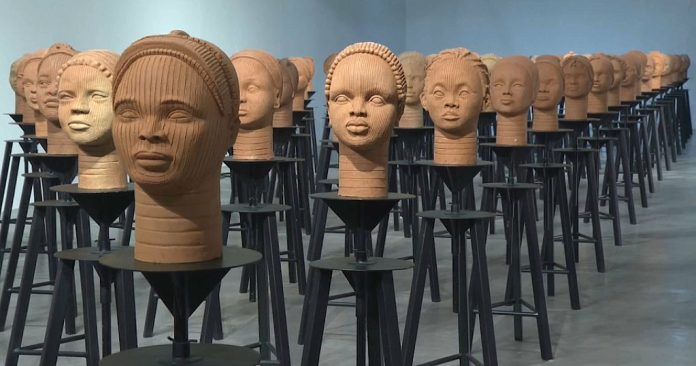The faces of the 108 Chibok girls who remain missing eight years after their abduction by Islamist insurgents have been sculpted in clay in a collaboration between French artist Prune Nourry, university students, professional potters and the families of the victims.
The 108 still missing Chibok schoolgirls abducted by Boko Haram in Nigeria in 2014 are remembered in a new sculpture exhibition in Lagos.
Inspired by ancient Nigerian Ife terracotta heads and titled “Statues Breathe Too”, the sculptures recreate faces, facial expressions and hair patterns of the victims.
The mass kidnapping initially sparked global outrage, with the slogan #BringBackOurGirls trending on social media as prominent figures including former US First Lady Michelle Obama pushed for her return.
Some 160 of the girls have since been released, some after years in captivity, but the story has long since faded from the headlines.
“It’s a permanent reminder of what happened, we had a period in our history in Nigeria where women, children, men, children were taken, some were recovered, some are still displaced to this day, some are still in captivity,” said Bring Back. Our Girls Lagos Coordinator, Habibat Balogun.
French artist Prune Nourry, behind the project, collaborated with 108 students from Obafemi Awolowo University. The families of the missing girls also participated by lending photos of their daughters for the portraits.
“I hope that people who see the show will remember it for the importance of educating girls and then for the fact that the sculpture can impersonate someone and capture the life that they breathe and the symbol of someone, of life. Then it’s also about collaboration, how together we can do more and maybe the fact that it will travel across Africa but also around the world and how we can keep bringing something to light that could be forgotten and shouldn’t be forgotten because it will always be a priority.” explained Prune Nourry. .
Nourry hopes her work will remind the world of this largely forgotten tragedy.
The sculptures on display at an art gallery in Lagos, Nigeria will go on a world tour in the near future.
“I hope it moves beyond the four walls of this exhibition space, moves beyond Nigeria to global appeal and again amplifies or shows the world the times we live in because this is not just Nigeria, I want to saying this is almost, it may also be related to what is happening in Iran,” reveals Tony Agbapuonwu, art curator.
A year after the girls were abducted, President Muhammadu Buhari rode a wave of goodwill to power after vowing to rescue them.
In early December, the nation’s national security adviser, Babagana Monguno, said the army remains committed to the cause, but added that it is an “intelligence-driven process, which means that unfortunately it is going to be industrious”, although eight years have passed since the kidnapping of these girls.
However, many parents are beginning to question the government’s commitment to girls’ freedom.
The Chibok community continues to suffer from attacks by Boko Haram and its splinter faction that has sworn allegiance to the Islamic State group.
This year, about a dozen of the missing girls returned amid news that some had died in custody.







